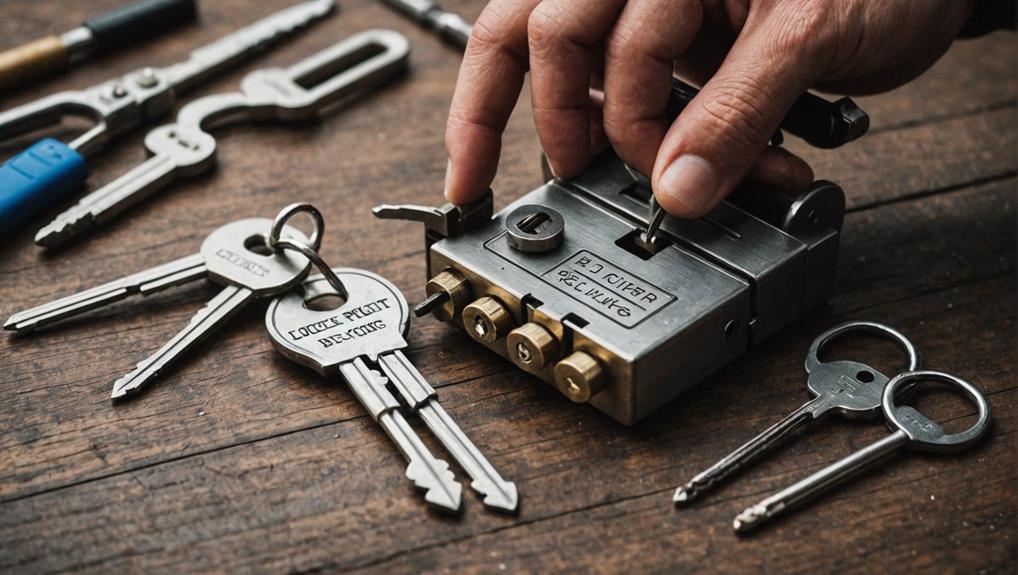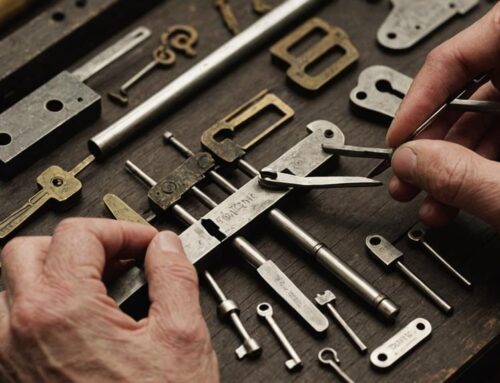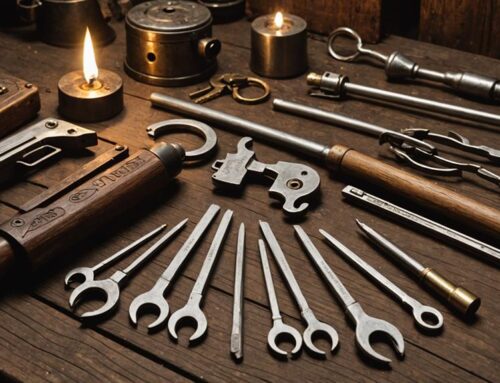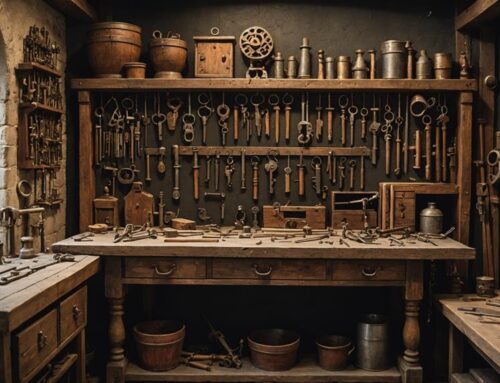Ready to plunge into the exciting world of lock picking? Learn the fundamentals of lock mechanisms, equip yourself with essential tools like lock picks and tension wrenches, and master techniques such as single pin picking and raking. Understand the importance of proper tensioning and troubleshooting common lock issues to enhance your skills. Remember, safety first with protective gear and high-quality tools. This beginner's guide lays the foundation for your lock picking journey, setting you on the path to becoming a proficient locksmith.
Key Takeaways
- Understand lock components: plug, driver pins, key pins, springs, and Bible for effective picking.
- Utilize essential tools: lock picks (hook, rake, diamond), tension wrench, and practice lock.
- Master basic techniques: light tension, single pin picking, and raking for successful picking.
- Focus on tensioning: apply consistent pressure with the tension wrench for pin manipulation.
- Troubleshoot common issues: stuck keys, lock challenges, and safety measures for successful picking.
Understanding Lock Mechanisms
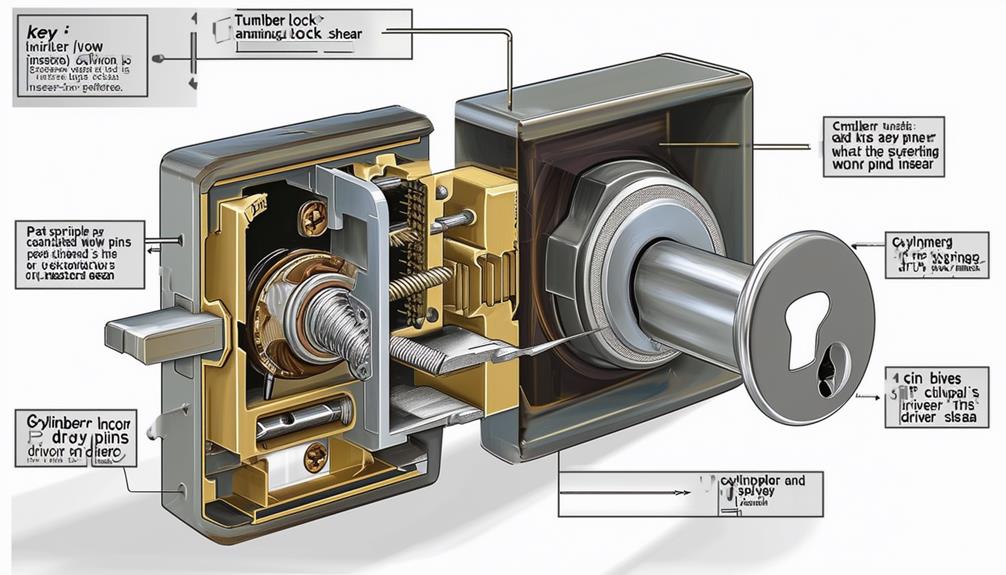
To begin understanding lock mechanisms, grasp the fundamental concept that locks operate based on intricate designs to secure valuables or spaces.
When delving into lock picking basics, it's vital to recognize that locks consist of various components that work together to prevent unauthorized access. The key components include the plug, driver pins, key pins, and springs. The plug is the part you insert the key into, while the driver pins and key pins are responsible for ensuring the lock stays closed without the correct key. The springs push the pins into the plug, creating a barrier that can only be bypassed with the correct key or through lock picking techniques.
Understanding the fundamentals of lock picking allows you to appreciate the complexity of these mechanisms and enhances your ability to identify potential vulnerabilities.
Understanding how these components interact is essential for aspiring lock pickers. By comprehending the inner workings of a lock, you can begin to grasp the vulnerabilities that can be exploited through lock picking. This foundational knowledge forms the basis for developing the skills necessary to manipulate locks effectively.
Essential Tools for Lock Picking
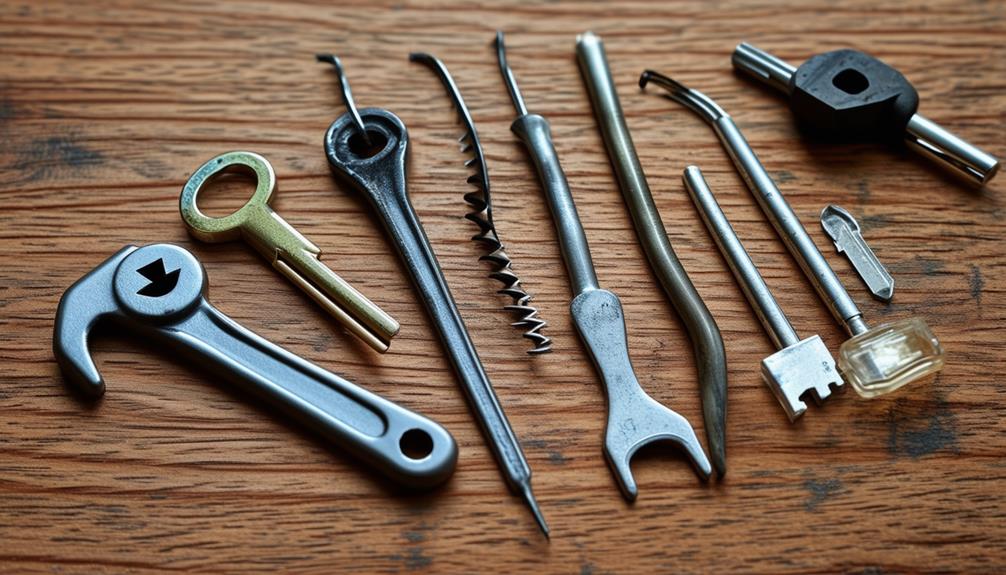
When delving into the world of lock picking, having the right tools at your disposal is vital for success. The right tools can make a significant difference in your learning curve and overall effectiveness.
Here are four vital tools you'll need in your beginner lock picking guide:
- Lock Picks: These are the primary tools used for manipulating the pins inside a lock. Start with a basic set that includes a variety of picks such as hooks, rakes, and diamonds, as recommended by top brands and models.
- Tension Wrench: Also known as a torque wrench, this tool is essential for applying rotational pressure to the lock cylinder while picking the pins. It helps create the necessary tension to set the pins correctly.
- Lock Picking Practice Lock: Investing in a practice lock designed for beginners will help you understand the mechanics of locks and improve your skills without damaging real locks.
- Lock Picking Guidebook or Online Resources: Having a guidebook or access to online tutorials can provide valuable insights and tips for beginners on how to pick different types of locks effectively.
These tools will set you on the right path as you begin your lock picking journey.
Getting Familiar With Lock Picks
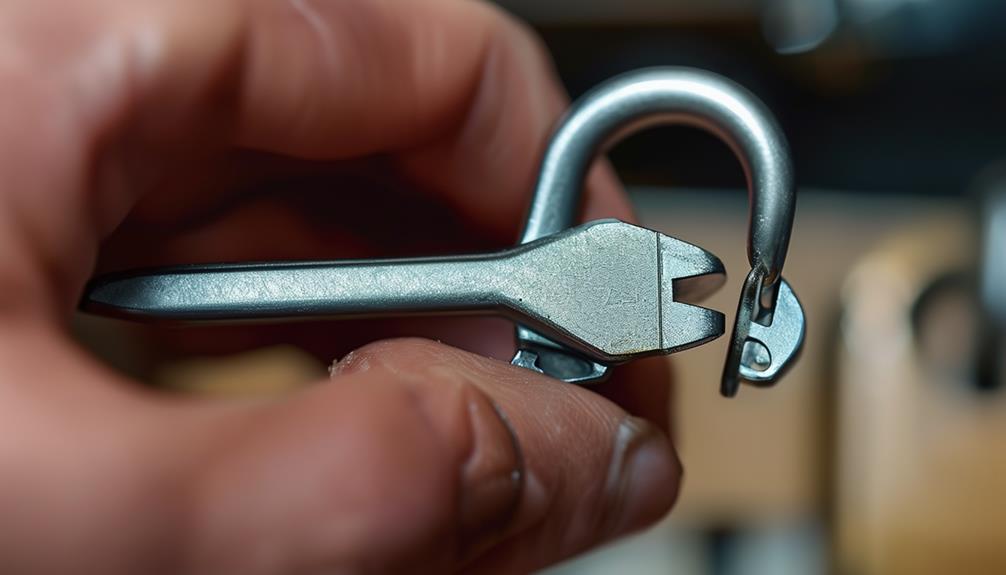
As you dive deeper into the domain of lock picking, becoming acquainted with your lock picks is an essential step in mastering this skill. Lock picks come in various shapes and sizes, each serving a specific purpose when it comes to manipulating the pins inside a lock. Here's a breakdown of some common lock picks you may encounter as a beginner:
| Type of Pick | Description |
|---|---|
| Hook Pick | Used to individually manipulate pins inside the lock |
| Rake Pick | Designed to quickly move multiple pins at once |
| Diamond Pick | Ideal for picking locks with tighter keyways |
Understanding the function of each type of pick will help you choose the right one for the lock you are attempting to pick. Experimenting with different picks on practice locks will also enhance your skills and familiarity with these tools. Remember, practice and patience are key in the world of lock picking for beginners.
Basic Pin Tumbler Lock Picking
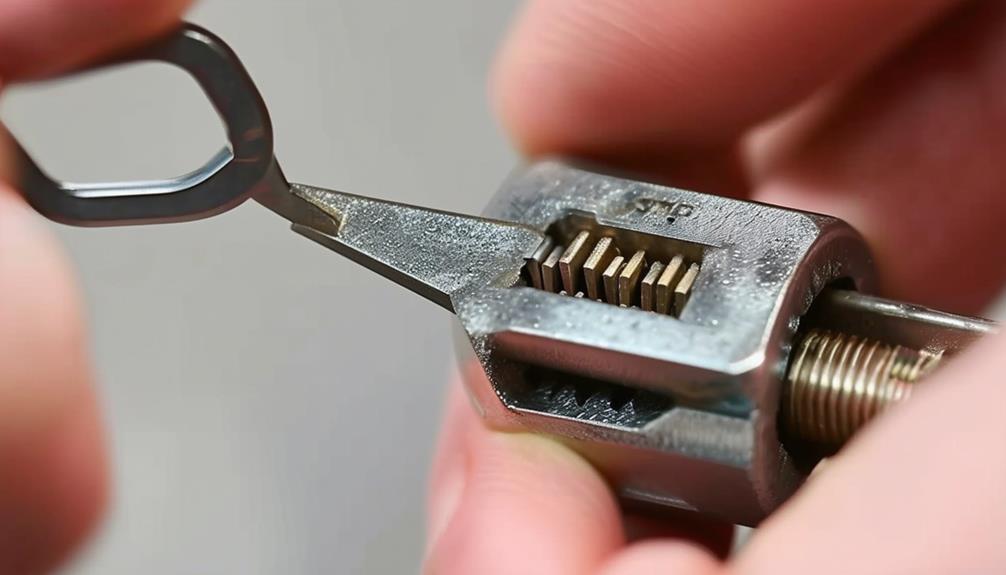
When it comes to basic pin tumbler lock picking, understanding the mechanics is key. The lock consists of a series of pins that need to be aligned correctly for the lock to turn.
You'll need the right tools and a good technique to successfully pick these locks. Familiarizing yourself with the essential techniques can greatly enhance your skills.
Let's explore the mechanics, tools needed, and the picking technique to get you started on your lock picking journey.
Pin Tumbler Mechanics
To understand the mechanics of pin tumbler locks, it's essential to grasp the basic components at play. These locks are commonly found in residential doors and padlocks.
Here is what you need to know about pin tumbler mechanics:
- Key Pins: These are different lengths to match the varying heights of the key cuts.
- Driver Pins: These sit above the key pins and are spring-loaded, blocking the cylinder from turning without the correct key.
- Springs: These push the driver pins down, creating tension that the key must overcome.
- Bible: This is the part of the lock housing the pins. When the correct key is inserted, it aligns the pins at the shear line, allowing the cylinder to turn.
Understanding these components will help you grasp the inner workings of a pin tumbler lock, aiding in your lock picking techniques for beginners.
Now, let's move on to the tools needed for this process.
Tools Needed
Understanding the importance of having the right tools is essential when delving into the domain of basic pin tumbler lock picking.
To begin your journey in mastering lock picking techniques for beginners, you'll need a few key tools. The first tool you require is a tension wrench, also known as a torque wrench. This tool is used to apply pressure to the lock's cylinder, allowing you to turn it once the pins are set.
The second essential tool is a lock pick. Lock picks come in various shapes and sizes, each serving a specific purpose in manipulating the pins within the lock.
These two tools, working in harmony, are fundamental in starting your lock picking endeavors. As you progress in your skills, you may explore additional tools like rakes and hook picks, but for now, focus on mastering the tension wrench and lock pick to lay a solid foundation for your lock picking journey.
Picking Technique
For successful basic pin tumbler lock picking, mastering the picking technique is essential.
When it comes to lockpicking techniques for beginners, here are some key points to keep in mind:
- Light Tension: Apply gentle pressure on the tension wrench to the lock's plug. Too much force can hinder the movement of pins.
- Single Pin Picking: Elevate each pin individually using a pick until all pins are set at the shear line. This method requires patience but is effective.
- Raking: Use a rake pick in a scrubbing motion while applying light tension. This technique can quickly set multiple pins, making it useful for beginners.
- Practice and Patience: Lock picking is a skill that improves with practice. Be patient and persistent, and don't get discouraged by initial difficulties.
Single Pin Picking Technique
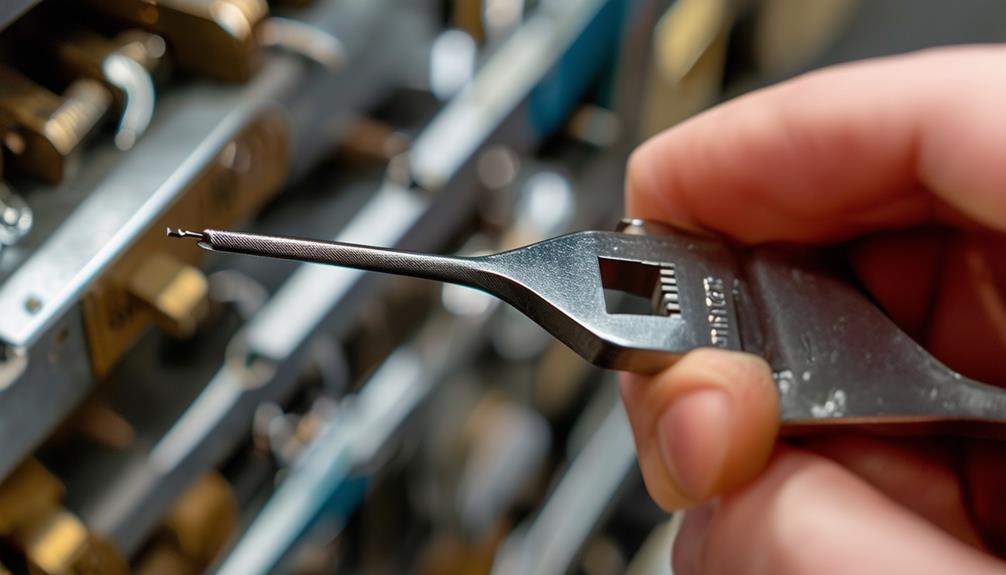
When tackling the Single Pin Picking Technique, your focus should be on precision and patience. This technique involves manipulating each individual pin within the lock to eventually open it.
To start, insert your tension wrench into the keyway at the bottom of the lock and apply slight pressure in the direction you'd turn the key. It's vital to maintain the correct tension, as this guarantees that the pins set properly without binding, which is significant for successful picking.
Next, take your pick and locate the pins inside the keyway. Gently lift each pin, one at a time, until you feel a slight movement or click. This click indicates that the pin has set at the shear line.
Continue this process for each pin until all pins are set, and the lock opens. Remember, practice is key to mastering this technique.
As a lock picking starter guide, it's important to approach this method with a steady hand and a focused mind. With practice, you'll improve your skills and gain a deeper understanding of how locks function, enhancing your overall proficiency in tools and techniques.
Raking Technique Explained
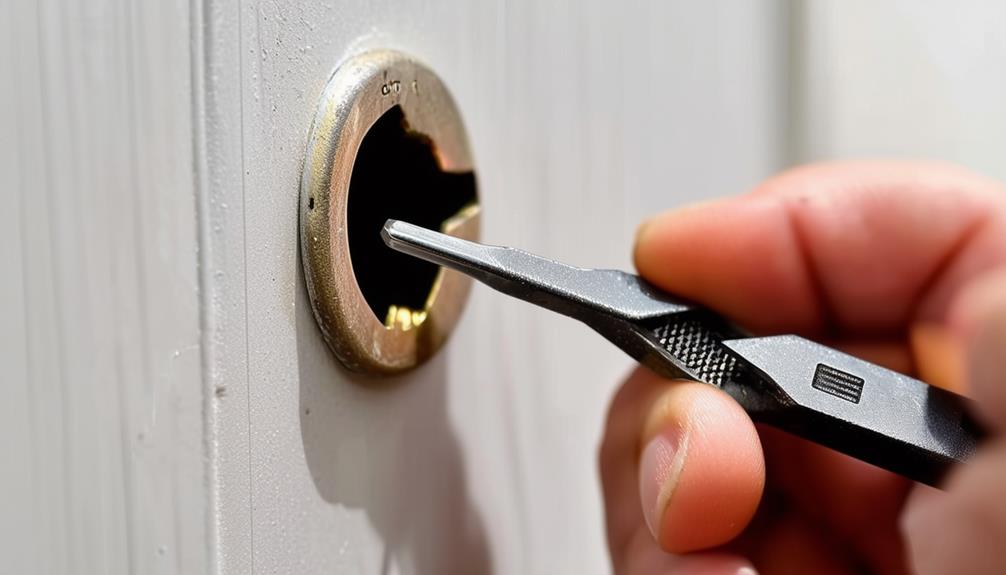
To master the Raking Technique in lock picking, you must first understand its fundamental principles. This technique involves swiftly moving a rake or a similar tool in and out of the keyway while applying slight pressure to the pins. Raking is particularly effective on low-security locks, making it a popular choice for beginners due to its simplicity.
Here are some key points to keep in mind when practicing the raking technique:
- Speed: Raking requires a quick but controlled movement. The goal is to jostle the pins into place without getting stuck.
- Pressure: Apply just enough pressure to the tension wrench to create a slight bind on the pins. Too much force can hinder the movement.
- Feedback: Pay attention to the feedback you receive from the lock. Sensitivity to subtle changes will help you determine the right pressure and movement.
- Practice: Like any skill, mastering the raking technique takes practice. Don't get discouraged if you don't succeed at first; keep refining your technique.
Tensioning the Lock Correctly
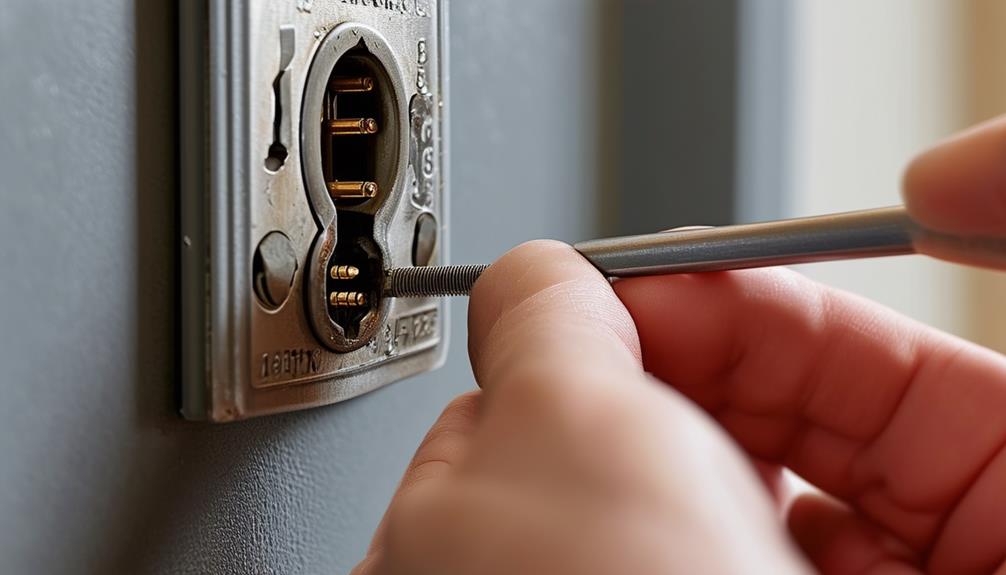
After familiarizing yourself with the raking technique and its application in lock picking, the next vital step is mastering the art of tensioning the lock correctly.
Tensioning the lock is essential because it involves applying just the right amount of pressure on the lock cylinder to create a bind between the driver pins and key pins. This bind is what allows you to manipulate the pins effectively to open the lock. Understanding the principles of lock picking techniques can greatly enhance your skills in this area.
To tension the lock properly, start by inserting your tension wrench into the keyway at the bottom of the lock. Apply slight pressure in the direction you'd turn the key to open the door.
The key here is to maintain consistent pressure without overdoing it, as excessive tension can hinder the pins from setting correctly.
Troubleshooting Common Challenges
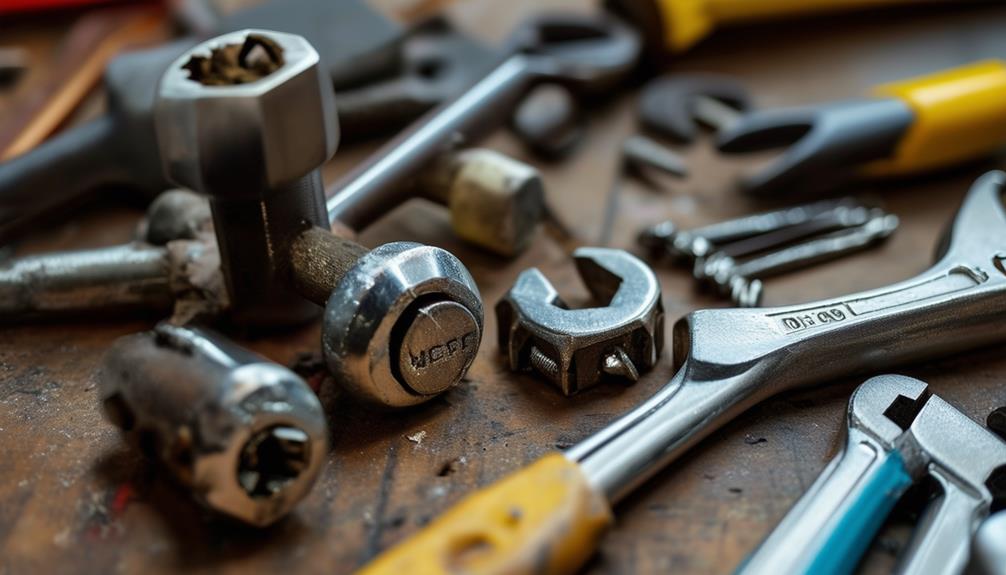
If you find yourself with a key stuck in the lock, don't panic. There are simple solutions to this common problem that you can try out.
Regular maintenance, such as cleaning and lubrication, can greatly reduce the chances of a key getting stuck and may help prevent future issues lock maintenance and cleaning.
Pin tumbler issues can also arise, but with the right technique, you'll be able to troubleshoot these challenges effectively.
Key Stuck Solutions
Having trouble with a stuck key in your lock can be frustrating and inconvenient. Here are some key stuck solutions that may help you resolve this common issue:
- Stay Calm: Panicking can make the situation worse. Take a deep breath and approach the problem methodically.
- Lubricate the Keyhole: Use a graphite lubricant or silicone spray to lubricate the keyhole. This can help loosen the key and make it easier to remove.
- Gently Jiggle the Key: Try gently jiggling the key up and down while attempting to remove it. Sometimes, this movement can dislodge the key from its stuck position.
- Seek Professional Help: If the key remains stuck despite your best efforts, it may be time to consult a professional locksmith. They've the expertise and tools to safely remove the key without causing further damage.
Pin Tumbler Issues
Pin tumbler locks are prevalent in many residential and commercial settings, known for their security and reliability. When encountering issues with pin tumbler locks during your step-by-step lock picking process, it is crucial to troubleshoot common challenges effectively. Here are some common problems you might face and how to tackle them:
| Issue | Solution |
|---|---|
| Key not turning smoothly | Use lubricant or graphite powder to ease movement. |
| Stiff key insertion | Clean the lock with compressed air and then lubricate the key. |
| Key goes in but won't turn | Check for any debris inside the lock and clean it out. |
| Inconsistent key operation | Adjust the pins by applying gentle pressure while picking. |
Lock Picking Safety Tips

When engaging in the practice of lock picking, prioritizing safety is essential to prevent accidents and damage. Understanding the potential vulnerabilities of locks can help you be more cautious while practicing. Here are four safety tips to guarantee safe lock picking for beginners:
1. Protect Your Eyes: Always wear safety glasses to shield your eyes from any metal slivers or debris that may come loose during the lock picking process. Your eyes are precious, so safeguard them at all times.
2. Use Proper Tools: Utilize high-quality lock picking tools that are suitable for the locks you're practicing on. Using the wrong tools can damage both the lock and your equipment, so invest in the right tools from the beginning.
Remember, knowledge of lock vulnerabilities can also guide your tool selection and technique.
3. Practice in a Controlled Environment: Find a quiet and controlled space to practice your lock picking skills. Distractions can lead to mistakes, so guarantee you have a calm environment to focus on the task at hand.
4. Know When to Stop: If you encounter significant resistance or aren't making progress, stop. Pushing too hard can break your tools or damage the lock irreversibly.
Take a break, reassess, and approach the lock with a clear mind.
Frequently Asked Questions
Can Lock Picking Damage the Lock?
Lock picking can potentially damage the lock if done incorrectly or forcefully.
It's essential to exercise caution and use the correct technique to prevent harm. Rushing or using excessive force may result in bending or breaking the lock components, rendering it inoperable.
Always approach lock picking with care and patience to avoid causing any unnecessary damage to the lock you're trying to open.
Is Lock Picking Legal?
Is lock picking legal? Yes, it's legal as long as you have explicit permission to pick the lock, such as for practicing locksmith skills or in emergency situations.
However, using lock picking tools on someone else's property without consent is illegal and can lead to consequences.
How Long Does It Take to Learn Lock Picking?
Learning lock picking can vary in time depending on your dedication and practice.
With consistent effort and focus, you could grasp the basics in a few weeks. Mastery might take several months of regular practice.
Remember, practice makes perfect, so the more you work at it, the quicker you'll improve.
Stay patient and keep practicing, and you'll soon feel confident in your lock picking skills.
Can I Use Household Items for Lock Picking?
Sure, you can use household items for lock picking, but it's like trying to fix a watch with a toothpick.
While it's possible in a pinch, having the right tools makes it much easier.
Bobby pins, paperclips, and even hairpins can work, but investing in proper lock picking tools will give you better results and make learning the skill smoother.
Are There Any Online Lock Picking Courses Available?
Yes, there are online lock picking courses available that can help you learn this skill.
These courses offer step-by-step guidance and practical demonstrations to enhance your understanding. You can access them from the comfort of your home and at your own pace.
They provide a structured approach to learning lock picking techniques and can be a valuable resource for beginners looking to improve their skills in this area.
Conclusion
Now that you've mastered the basics of lock picking, remember to practice regularly to hone your skills. Like a musician perfecting their craft, repetition is key to becoming proficient. Keep exploring different types of locks and techniques to expand your knowledge and expertise. With dedication and patience, you'll soon be able to tackle more challenging locks with ease. Happy picking!

